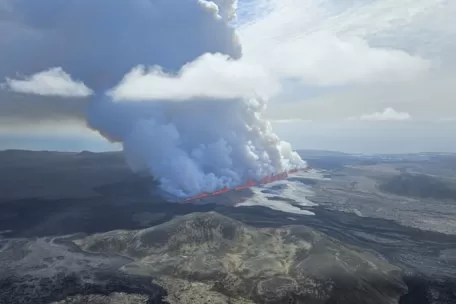- In short: A volcano in Iceland has erupted for the fifth time since December, sending lava high into the sky.
- The eruption has forced people in a nearby town and tourist hotspot to evacuate.
- What’s next? Authorities in Iceland are working to understand the size and scale of the latest eruption.
A volcano in Iceland has erupted for the fifth time since December, shooting lava 50 metres into the air along a crater that authorities say is “2.5km long and still growing”.
Local media reported that a state of emergency had been declared by the Icelandic police force.
Icelandic authorities sent notices to locals and workers in the town of Grindavik, warning of an impending eruption Wednesday morning local time.
Local media reported that people were evacuated from the town and the nearby tourist hotspot Blue Lagoon geothermal pool just before midday, following an earthquake in the area.
The Icelandic Meteorological Office (IMO) said the lava “jets are reaching a height of at least 50 metres and the length of the crater appears to be 2.5km and still growing” in a statement on Wednesday afternoon local time.
It said the coast guard helicopter was surveying the area to get a more accurate understanding of the eruption’s size and location.
Authorities had warned of the risk of renewed volcanic activity in the Reykjanes Peninsula, just south of the capital Reykjavik, as studies showed magma accumulated underground.
The IMO also recorded some 400 earthquakes in the area of the volcano’s crater in the past week.
The latest event follows the end of another eight-week-long eruption on the peninsula that saw molten rock spew from the ground.
The fiery spectacle underlines the challenges the island nation of almost 400,000 people face as scientists have warned eruptions could happen over and over in Reykjanes for decades or even centuries.
The eruption was the eighth on the peninsula, home to some 30,000 people, since 2021 when geological systems that were dormant for some 800 years again became active.
Previous incidents had disrupted district heating, closed key roads and even razed several houses in Grindavik, where only a few residents have since returned.
In an attempt to prevent further damage, man-made barriers have been built to steer lava away from infrastructure including the Svartsengi geothermal power plant, the tourist drawcard Blue Lagoon outdoor spa and Grindavik.
Icelanders often refer to their country as the “Land of Fire and Ice” as a tribute to its otherworldly landscape forged by glaciers and volcanoes. Iceland is positioned between the Eurasian and North American tectonic plates, making it a seismic hotbed.
While a 2010 eruption in a different part of Iceland grounded some 100,000 flights internationally due to huge ash clouds, Reykjanes is typically home to fissure outbreaks which do not reach into the stratosphere.
ABC/Reuters
